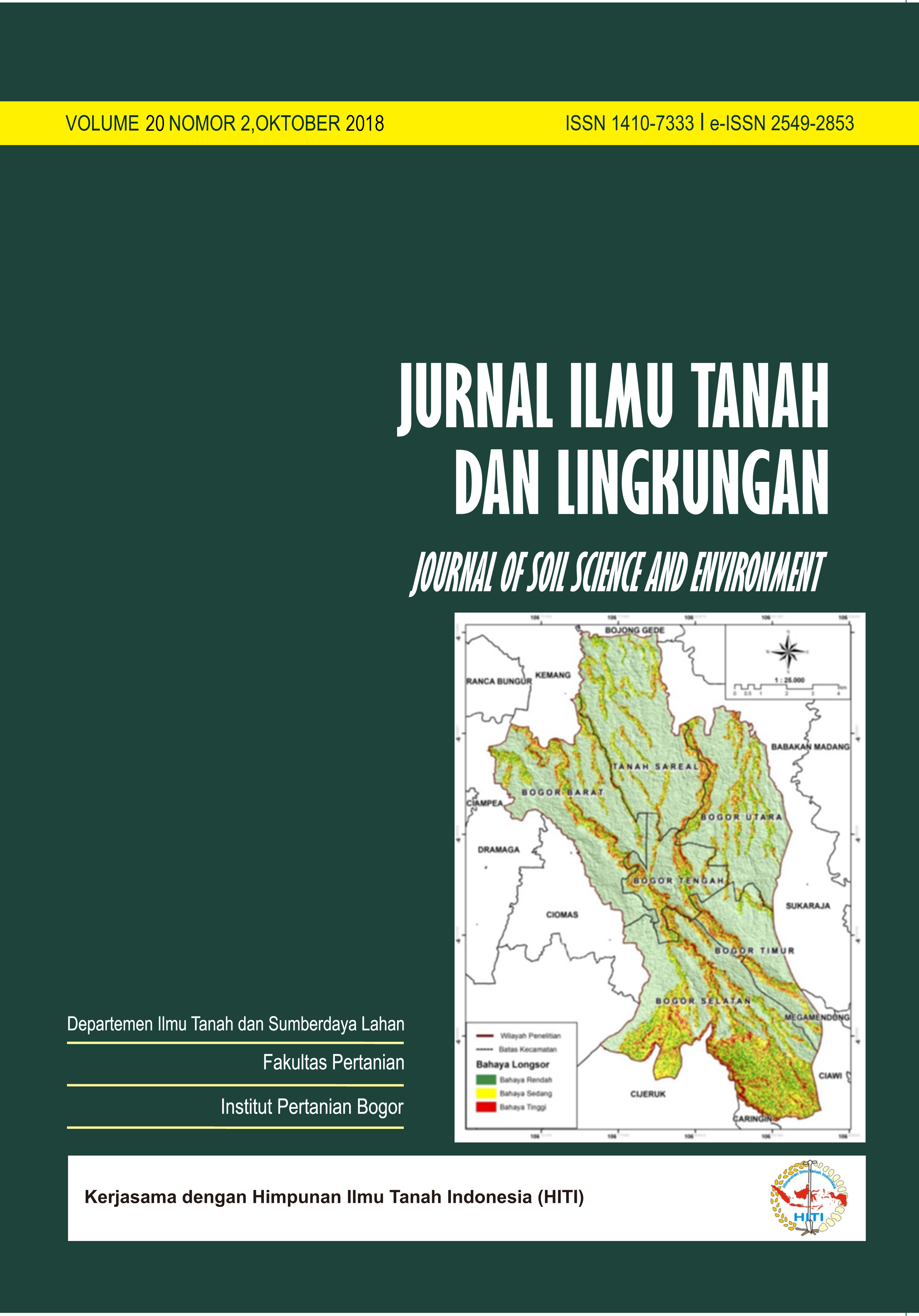Quality and Production of Vermicompost Using African Night Crawler Worms (Eudrilus eugeniae)
Kualitas dan Produksi Vermikompos Menggunakan Cacing African Night Crawler (Eudrilus eugeniae)
Abstract
Adding organic fertilizer such as vermicompost can be done to overcome the deficiency problem of soil organic matter. One of the worm species which can be used in vermicomposting is Eudrilus eugeniae. Purpose of this research was to know how the combination of cow dung and rice straw impacts vermicompost quality from organic carbon, N, P, total K, urease enzyme activity and vermicompost production. Treatment that used in this research is randomized completely design with 4 treatments. The treatments are P1: feed 400 g of cow dung, P2: feed 400 g of rice straw, P3: feed 280 g of cow dung and 120 g of rice straw, and P4: feed 140 g of cow dung and 60 g of rice straw. The research result shows that real treatment impacts all parameters on the produced vermicompost. Production result is determined by ratio value of output/input (O/I). Quality and production of vermicompost on P4 is a treatment with the best result. It is because the combination of cow dung and rice straw gives a relatively complete macro nutrient result and the higher feed dose will gives higher vermicompost production.
Downloads
References
Agus, C., E. Faridah, D. Wulandari dan B.H. Purwanto. 2014. Peran mikroba starter dalam dekomposisi kotoran ternak dan perbaikan kualitas pupuk kandang. Jurnal Manusia dan Lingkungan, 21(2): 179-187.
Ansari, H., Jamilah dan Mukhlis. 2014. Pengaruh dosis pupuk dan jerami padi terhadap kandungan unsur hara tanah serta produksi padi sawah pada sistem tanam SRI (System of Rice Intensification). Jurnal Online Agroekoteknologi, 2(3):1048-1055.
Banerjee, S. and A. Aggarwal. 2012. Isolation, partial purification, characterization and inhibition of urease (EC 3.5.1.5) enzyme from the Cajanus cajan seeds. Asian Journal of Bio Science, 7(1):203-209.
Banu, J.R., I.T. Yeom, S. Esakkiraj, N. Kumar and S. Logakanthi. 2008. Biomanagement of sago-sludge using an earthworm, Eudrilus eugeniae. J. Environ Bio., 9(1):453-468.
Blakemore, R.J. 2015. Eco taxonomic profile of an iconic vermicomposter the ‘African Night Crawler’ earthworm, Eudrilus eugeniae. African Invertebrates, 56(3): 527-548.
Dominguez, J., C.A. Edwards and M. Webster. 2000. Vermicomposting of sewage sludge: effect of bulking materials on the growth and reproduction of the earthworm Eisenia andrei. Pedobiologia, 44(1):24-32.
Gaur, A.C. 1983. A Manual Rural Composting FAO. The United Nation, Rome.
Guerrero, R.D., L.G. Villegas and L.A. Guerrero. 1999. Studies on the production and utilization of vermicompost produced with the African Night Crawler (Eudrilus eugeniae) in the Philippines. Philippine Technology Journal, 24(1):57-62.
Hermawan. 2014. Usaha Budidaya Cacing Tanah Lumbricus rubellus. Pustaka Baru, Yogyakarta.
Lazcano, C., M.G. Brandon and J. Dominguez. 2008. Comparison of the effectiveness of composting and vermicomposting for the biological stabilization of cattle manure. Chemosphere, 72: 1013-1019.
Lingaiah, V. and P. Rajasekaran P. 1986. Biodigestion of cowdung and organic wastes mixed with oil cake in relation to energy. Agricultural Wastes, 17: 161-173.
Meryandini, A., W. Wahyu, M. Besty, C.S. Titi, R. Nisa dan S. Hasrul. 2009. Isolasi bakteri selulolitik dan karakterisasi enzimnya. Makara Journal of Sains, 13(1):33-38.
Parmelee, R.W., M.H. Beare, W. Cheng, P.F. Hendrix, S.J. Rider, D.A. Crossley and D.C. Coleman. 1990. Earthworm and enchytraeids in conventional and no tillage agroecosystems: A biocide approach to asses their role in organic matter breakdown. Biology Fertility Soils, 10: 1–10.
Pathma, J. and N. Sakthivel. 2012. Microbial diversity of vermicompost bacteria that exhibit useful agricultural traits and waste management potential. Springerplus, 1(26): 1-19.
[Permentan] Peraturan Menteri Pertanian Nomor 70/Permentan/SR.140/10/2011. 2011. Pupuk Organik, Pupuk Hayati, dan Pembenah Tanah. Kementerian Pertanian.
Reanida, P., Supriyanto dan Salamun. 2012. Eksplorasi Bakteri Selulolitik Dari Tanah Mangrove Wonorejo Surabaya [Tesis]. Universitas Airlangga. Surabaya.
Savci, S. 2012. Investigation of effect of chemical fertilizers on environment. APCBEE Proceedia, 287-292.
Schinner, F., E. Kandeler and O.R. Margesin. 1996. Methods in Soil Boilogy. Spinger, German.
Sirko, A. and R. Brodzik. 2000. Plant ureases: roles and regulations. Acta Biochimica Polonica, 47(4):1189-1194.
Subowo, G. 2010. Strategi efisiensi penggunaan bahan organik untuk kesuburan dan produktivitas tanah melalui pemberdayaan sumberdaya hayati tanah. Jurnal Sumberdaya Lahan, 4(1):13-25.
Surtinah. 2013. Pengujian kandungan unsur hara dalam kompos yang berasal dari serasah tanaman jagung manis (Zea mays). Jurnal Ilmiah Pertanian, 11(1):16-26.
Susanti, P.D. dan W. Halwany. 2017. Dekomposisi serasah dan keanekaragaman makrofauna tanah pada Hutan Tanaman Industri Nyawai (Ficus variegate Blume). Jurnal Ilmu Kehutanan, 11(2):212-223.
Susetyarini, R.E. 2007. Jumlah dan berat cocoon cacing tanah (Lumbricus rubellus) yang diberi PMSG, pakan tambahan berupa kotoran domba dan kotoran sapi. Jurnal Protein, 14(1):1-8.
Trimulat. 2013. Membuat dan Memanfaatkan Kascing Pupuk Organik Berkualitas. PT Agromedia Pustaka. Jakarta.
Wang, B., X. Sha, B.L. Guo and H.Z. Guang. 2012. Changes in soil nutrient and enzyme activities under different vegetations in the loess plateau area, Northwest China. Catena, 92: 186–195.
Yuliarti, N. 2009. 1001 Cara Menghasilkan Pupuk Organik. Lily Publisher, Yogyakarta.
Department of Soil Science and Land Resources Departemen Ilmu Tanah dan Sumberdaya Lahan, Faculty of Agriculture Fakultas Pertanian, IPB University



















